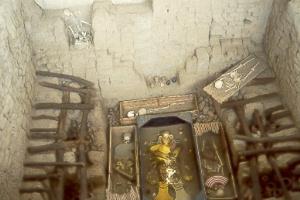
| Chiclayo Area | Trujillo Area | Trujillo Archaeology |
|
Our second trip to Peru. Actually we were mainly going to Ecuador but because we were flying on Aeroplan points, Lima was the closest airport to Ecuador. Since we had to go through Lima we decided to visit some areas of the country we never had time to visit last time. We arrived late at Lima airport (from San Paulo, Brazil) and as soon as we passed through customs several people approached us about flights to Cusco. Having already been to Cusco our plan was to get the first available flight north either to Chiclayo, Trujillo or Cajamarca. It was late and instead of finding a hotel for the night and since early flights start to leave at around 6am we spent the night in the airport. On the upper concourse there is a lounge where you spend you time if you spend about $US5. Comfortable lounging seats. |
We were hoping to get a flight to Cajamarca but it seems only one of Peru's six airlines serve that community. Every airline flies to Cusco, there are plenty of cheap flights. It appears that the airlines rotate to serve Cajamarca and presently it was Aero Condor, an airline we had bad experiences with on our previous vacation. We decide to fly to Chiclayo, then bus to Trujillo before returning to Lima for our flight to Quito, Ecuador.
Chiclayo is Peru's fourth largest city and probably one of the fastest growing. There is little of interest in the city, even the main plaza and church are nothing spectacular but its lack of tourists and its nearby ruins definitely make it worth a visit.
You will see few signs of tourist infrastructure around the city and you might even be the only gringo in town. Instead of tour agencies and
sovereign shops near the main plaza (Plaza de Armas) you will find various types of stores selling clothing, shoes, home
furniture and food stuff. The few tour agencies around offer tours of the nearby ruins which include pre-Inca ruins of
Mocha and Lambayeque cultures.

In 1987 local archaeologist Dr. Walter Alva became aware of a huge influx of unknown objects on the black market. Careful questioning revealed that huaqueros (grave robbers) have found a new tomb and fortunately for archaeology only one tomb had been plundered and the one of the most significant archaeological finds in 50 years was preserved. Many people call Señor de Sipán (Lord of Sipán) the Peruvian King Tut. Several of tombs have been restored with replicas to show what they looked like 1500 years ago and there is a small onsite museum. The real artifacts are located in the Bruning Museum in nearby Lambayeque. You can also hike to the top of some of the barely recognizable ceremonial adobe pyramids. For the past 1500 years El Nino has taken its toll on the mud bricks of the pyramids.
Nearby Lambayeque is worth a visit not just for the Bruning Museum which, except for the Nation Museum in Lima, is probably the finest museum I visited in Peru but because it is also an attractive small city. The museum contains almost all the artifacts recovered from Sipán plus Moche and Chimú artifacts from nearby sites. The longest covered wooden balcony in the world is supposedly located in Lambayeque. A new museum is being builted to house the archaeological treasures of the region, its an impressive looking structure which still sits empty. The city is also famous for a sweet pastry cake called King-Kongs.
Just north of Lambayeque is the ancient city of Túcume also called El Valle de los Pirámides, a complex of over 20 adobe pyramids. The largest pyramid, Huaca Larga, at 700m long, 280m wide, and 30m tall is the largest adobe structure in South America. Erosion has taken its toll on the structures which are a product of the Lambayeque culture, whose history is outlined in the nearby museum. No spectacular tombs have been unearthed but its the sheer size of the site that makes it a worthwhile visit.
All these sites can be visited using local transportation or an organized tour will allow you to visit the sites in comfort. Because of the lack of tourists and tour company competition, organized tours are more expensive in Chiclayo then in other parts of Peru but if you can get a large group together you can share the cost.
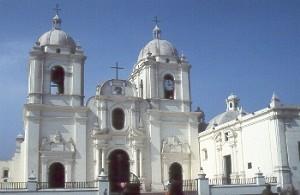
Trujillo is only a three hour bus ride from Chiclayo. There are also several daily flights from Lima or about 8 hours on the bus. Long distance buses can be a joy in Peru, for a little extra money you will get comfortable reclining seats with the better bus companies.
There is plenty of debate with Arequipa whether Trujillo is the second or third largest city in Peru. A beautiful city itself, Trujillo is also located near the most impressive archaeological site, next to Machu Picchu, in Peru Chan Chan plus several other important sites.
Trujillo is another attractive colonial city with beautiful wrought-iron grillwork fronting almost every building and with the pastel colours of the buildings this results in a unique looking city centre. The climate is also pleasant, warm and dry without the unpleasant coastal fog found in Lima.
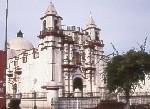
Like many Peruvian cities there are plenty of churches and mansions to gawk at although getting inside is sometimes a matter of luck. The churches open at very irregular hours but a number of the mansions have been converted into banks which can be visited during business hours. Some of the banks have small museums and art galleries located inside, it certainly makes changing money or traveler cheques a more pleasant experience.
Like all Peruvian cities there is a large main square or Plaza de Armas. Trujillo's plaza has an impressive statue of the heroes of Peruvian independence. There is a large cathedral and many colourful mansions including one that is now Trujillo's most expensive hotel, Hotel Libertador which is about $US100 per night. We stayed at the Hotel Continental for about $US25 which was across the street from the main market (Mercado Modelo), an interesting visit itself. You can buy almost anything you want here for very low prices.
Along with the main cathedral there are many other colonial churches like El Carmen, Santo Domingo, San Francisco, and many others all located near the city centre within walking distance of each other. Getting inside is a matter of luck, they all have irregular hours.
There is a decent archaeological museum in town, Museo Arqueológico de la Universidad de Trujillo. It has a fair number of artifacts including some detail on the restoration of Huaca de la Luna. Displays are in Spanish.
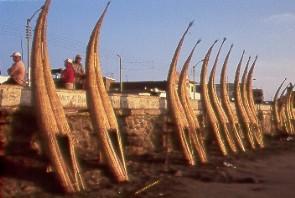
Eating is a distinct pleasure in Trujillo, along with what seems to be more pastry shops per square kilometre than anywhere I've been plus you can get excellent three course meals for about $US3. If your really cheap I've seen set lunches for $US1.50.
Near Trujillo is the seaside town of Huanchaco which is very low key and still retains its fishing village ambience. The main interest here are the totora reed boats called caballitos (little horses). When the surf is good fisherman paddle their boats out beyond the breakers to fish and then surf back to the beach with their catch. Some people believe surfing was invented here. There's not much to do here but then
that's the idea. Relax and Enjoy.
Although Trujillo is a beautiful city, most people visit the area for the archaeological
sites although the national government seems only to heavily promote
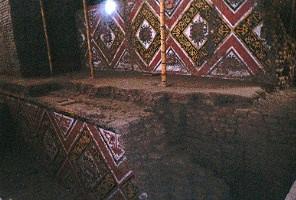 Chan Chan. There are plenty of tour groups to choose from, it probably does not matter who you pick since the different agencies will probably pool their groups to fill a bus. A full day tour will cost about 80 sols per person.
Chan Chan. There are plenty of tour groups to choose from, it probably does not matter who you pick since the different agencies will probably pool their groups to fill a bus. A full day tour will cost about 80 sols per person.
The Temples of the Sun and Moon (Las Huacas del Sol y de la Luna) were built by the Moche around 500 AD are usually visited in the morning since afternoon windstorms will whip up the dust.
The Huaca del Sol is the largest pre-Columbian structure in Peru, it measures 342 metres long, 159 metres wide and 45 metres high containing about 140 million adobe bricks. A millennium and half have caused much damage so that today the pyramid looks like a giant pile of crude bricks. Despite this the pyramid is still an impressive site although few graves or rooms have been found so the pyramid must have been a huge ceremonial site.
About 500 metres away is Huaca de la Luna which although less impressive in size has yielded many more artifacts. The Pyramid of the Moon is riddled with rooms which contained ceramics, precious metals and beautiful polychrome friezes. The site is presently undergoing restoration so if your lucky you will see
archaeology in action.
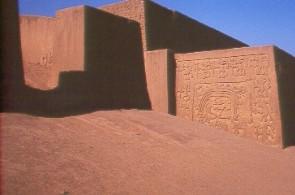
Along with Moche sites the other sites around Trujillo are Chimu and were builted around 1000 AD. Chan Chan is the largest site in the area but you will probably also stop at either La Huaca Esmeralda or La Huaca Arco Iris on your way to Chan Chan.
Huaca Arco Iris (Rainbow Temple) is one of the best preserved temples in the area, mainly due to the fact that it was covered in sand until the 1960's, the 1983 El Niño caused damage to the friezes. The temple took five years to excavate and restore. The temple consists of a two metre thick defensive wall while the temple itself is 800 square metres and about 7.5 metres high. The walls are coved with repeated rainbow designs and in some areas you can just make out faint traces of yellow paint.
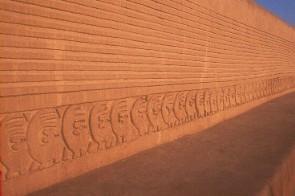
The main site visitors to the area come to see is Chan Chan, the largest pre-Columbian city in the Americans covering an area of about 28 square kilometres. It is the largest mud city in the world and at its height must have housed 50,000 people. The Incas conquered the Chimu Empire but mainly left them undisturbed since they were mainly interested in empire building not treasure hunting. A few decades of Spanish looting left little of the Chan Chan treasures. Today, only the mud walls and a few decorations remain. There is also a small site museum to visit.
One of subcities, or Royal Compounds (there are at least nine maybe more) had been partially restored, Tschudi. This large compound is entered through a thick defensive wall that probably stood 10 metres high in the past; time, erosion and El Niño has taken its toll. Inside this compound you will see several large courtyards, geometric designs, adobe friezes, and other signs of a once great city. There is a tower or mirador from which you can get a good view of the entire huge site.
An overnight bus from Trujillo to Lima, a taxi from the bus station to the airport then a flight to Quito, Ecuador. We flew with Aero Continente which had to be of the most unorganized and chaotic check-ins I've ever experienced. They were boarding three international flights at the same time, all leaving within 45 minutes of each other; Quito, Bogotá, and Caracas. I was sure our luggage was going to end up in Caracas but with the slow processing at immigration at Quito airport our luggage was waiting for us when we got through immigration in Quito, Ecuador.
| Visit the Amazon Basin |
Visit the Southern Highlands |
Visit the South Coast | Visit the Andean Peru |
Return to Travel Page |
Return to Main Page |